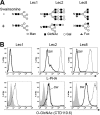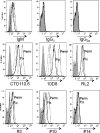Antibodies that detect O-linked β-D-N-acetylglucosamine on the extracellular domain of cell surface glycoproteins
- PMID: 24573683
- PMCID: PMC4036252
- DOI: 10.1074/jbc.M113.492512
Antibodies that detect O-linked β-D-N-acetylglucosamine on the extracellular domain of cell surface glycoproteins
Abstract
The transfer of N-acetylglucosamine (GlcNAc) to Ser or Thr in cytoplasmic and nuclear proteins is a well known post-translational modification that is catalyzed by the O-GlcNAc transferase OGT. A more recently identified O-GlcNAc transferase, EOGT, functions in the secretory pathway and transfers O-GlcNAc to proteins with epidermal growth factor-like (EGF) repeats. A number of antibodies that detect O-GlcNAc in cytosolic and nuclear extracts have been described previously. Here we compare seven of these antibodies (CTD110.6, 10D8, RL2, HGAC85, 18B10.C7(#3), 9D1.E4(#10), and 1F5.D6 (#14) for detection of the O-GlcNAc modification on extracellular domains of membrane or secreted glycoproteins that may also carry various N- and O-glycans. We found that CTD110.6 binds not only to O-GlcNAc on proteins but also to terminal β-GlcNAc on the complex N-glycans of Lec8 Chinese hamster ovary (CHO) cells that lack UDP-Gal transporter activity and express GlcNAc-terminating, complex N-glycans. We show that CTD110.6, #3, and #10 antibodies can be used to detect cell surface glycoproteins bearing O-GlcNAc. Cell surface glycoproteins recognized by CTD110.6 antibody included NOTCH1 that possesses many EGF repeats with a consensus site for EOGT. Knockdown of CHO Eogt reduced binding of CTD110.6 to Lec1 CHO cells, and expression of a human EOGT cDNA increased the O-GlcNAc signal on Lec1 cells and the extracellular domain of NOTCH1. Thus, with careful controls, antibodies CTD110.6 (IgM), #3 (IgG), and #10 (IgG) can be used to detect membrane and secreted proteins modified by O-GlcNAc on EGF repeats.
Keywords: Antibodies; CHO; Flow Cytometry; GlcNAc-terminating N-Glycans; Lec1; Lec8; Mutant; O-GlcNAc; O-GlcNAcylation.
Figures








Similar articles
-
Impaired O-linked N-acetylglucosaminylation in the endoplasmic reticulum by mutated epidermal growth factor (EGF) domain-specific O-linked N-acetylglucosamine transferase found in Adams-Oliver syndrome.J Biol Chem. 2015 Jan 23;290(4):2137-49. doi: 10.1074/jbc.M114.598821. Epub 2014 Dec 8. J Biol Chem. 2015. PMID: 25488668 Free PMC article.
-
O-GlcNAc-specific antibody CTD110.6 cross-reacts with N-GlcNAc2-modified proteins induced under glucose deprivation.PLoS One. 2011 Apr 19;6(4):e18959. doi: 10.1371/journal.pone.0018959. PLoS One. 2011. PMID: 21526146 Free PMC article.
-
Tandem mass spectrometry identifies many mouse brain O-GlcNAcylated proteins including EGF domain-specific O-GlcNAc transferase targets.Proc Natl Acad Sci U S A. 2012 May 8;109(19):7280-5. doi: 10.1073/pnas.1200425109. Epub 2012 Apr 19. Proc Natl Acad Sci U S A. 2012. PMID: 22517741 Free PMC article.
-
O-GlcNAc glycans in the mammalian extracellular environment.Carbohydr Res. 2025 Mar;549:109378. doi: 10.1016/j.carres.2025.109378. Epub 2025 Jan 10. Carbohydr Res. 2025. PMID: 39813972 Review.
-
EOGT and O-GlcNAc on secreted and membrane proteins.Biochem Soc Trans. 2017 Apr 15;45(2):401-408. doi: 10.1042/BST20160165. Biochem Soc Trans. 2017. PMID: 28408480 Free PMC article. Review.
Cited by
-
Detection and Analysis of Proteins Modified by O-Linked N-Acetylglucosamine.Curr Protoc. 2021 May;1(5):e129. doi: 10.1002/cpz1.129. Curr Protoc. 2021. PMID: 34004049 Free PMC article.
-
Genetic recoding to dissect the roles of site-specific protein O-GlcNAcylation.Nat Struct Mol Biol. 2019 Nov;26(11):1071-1077. doi: 10.1038/s41594-019-0325-8. Epub 2019 Nov 6. Nat Struct Mol Biol. 2019. PMID: 31695185 Free PMC article.
-
New Insights Into the Biology of Protein O-GlcNAcylation: Approaches and Observations.Front Aging. 2021 Mar 12;1:620382. doi: 10.3389/fragi.2020.620382. eCollection 2020. Front Aging. 2021. PMID: 35822169 Free PMC article.
-
Recent Advances in the Rheumatic Fever and Rheumatic Heart Disease Continuum.Pathogens. 2022 Jan 28;11(2):179. doi: 10.3390/pathogens11020179. Pathogens. 2022. PMID: 35215123 Free PMC article. Review.
-
O-GlcNAcylated peptides and proteins for structural and functional studies.Curr Opin Struct Biol. 2021 Jun;68:84-93. doi: 10.1016/j.sbi.2020.12.005. Epub 2021 Jan 9. Curr Opin Struct Biol. 2021. PMID: 33434850 Free PMC article. Review.
References
-
- Varki A., Cummings R. D., Esko J. D., Freeze H. H., Stanley P., Bertozzi C. R., Hart G. W., Etlzler M. E. (2009) Essentials of Glycobiology, 2nd Edition, Cold Spring Harbor Laboratory, Cold Spring Harbor, NY - PubMed
-
- Matsuura A., Ito M., Sakaidani Y., Kondo T., Murakami K., Furukawa K., Nadano D., Matsuda T., Okajima T. (2008) O-Linked N-acetylglucosamine is present on the extracellular domain of Notch receptors. J. Biol. Chem. 283, 35486–35495 - PubMed
-
- Sakaidani Y., Furukawa K., Okajima T. (2010) O-GlcNAc modification of the extracellular domain of Notch receptors. Methods Enzymol. 480, 355–373 - PubMed
-
- Sakaidani Y., Ichiyanagi N., Saito C., Nomura T., Ito M., Nishio Y., Nadano D., Matsuda T., Furukawa K., Okajima T. (2012) O-Linked N-acetylglucosamine modification of mammalian Notch receptors by an atypical O-GlcNAc transferase Eogt1. Biochem. Biophys. Res. Commun. 419, 14–19 - PubMed
-
- Sakaidani Y., Nomura T., Matsuura A., Ito M., Suzuki E., Murakami K., Nadano D., Matsuda T., Furukawa K., Okajima T. (2011) O-Linked-N-acetylglucosamine on extracellular protein domains mediates epithelial cell-matrix interactions. Nat. Commun. 2, 583. - PubMed
Publication types
MeSH terms
Substances
Grants and funding
LinkOut - more resources
Full Text Sources
Other Literature Sources
Molecular Biology Databases
Miscellaneous

